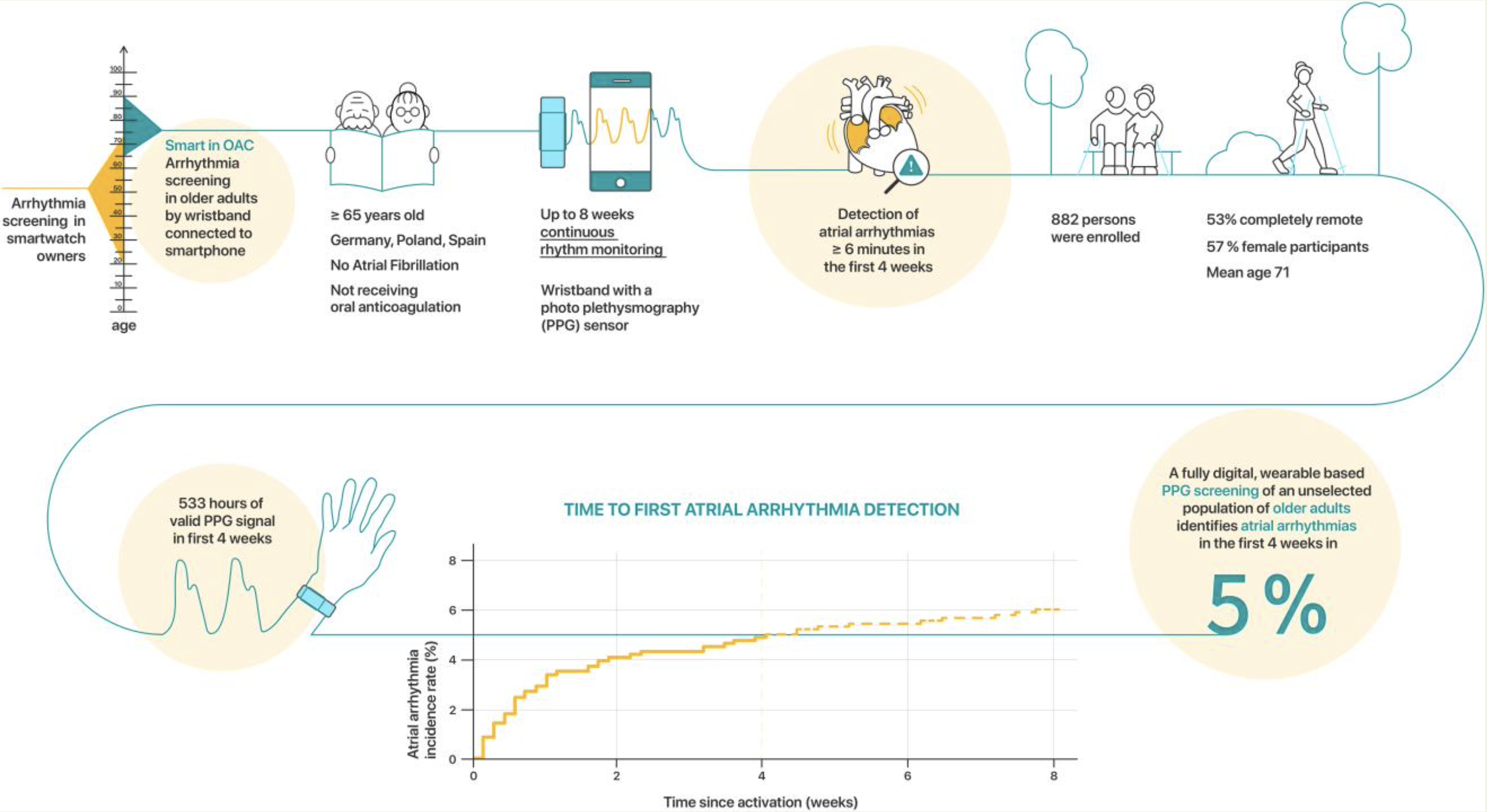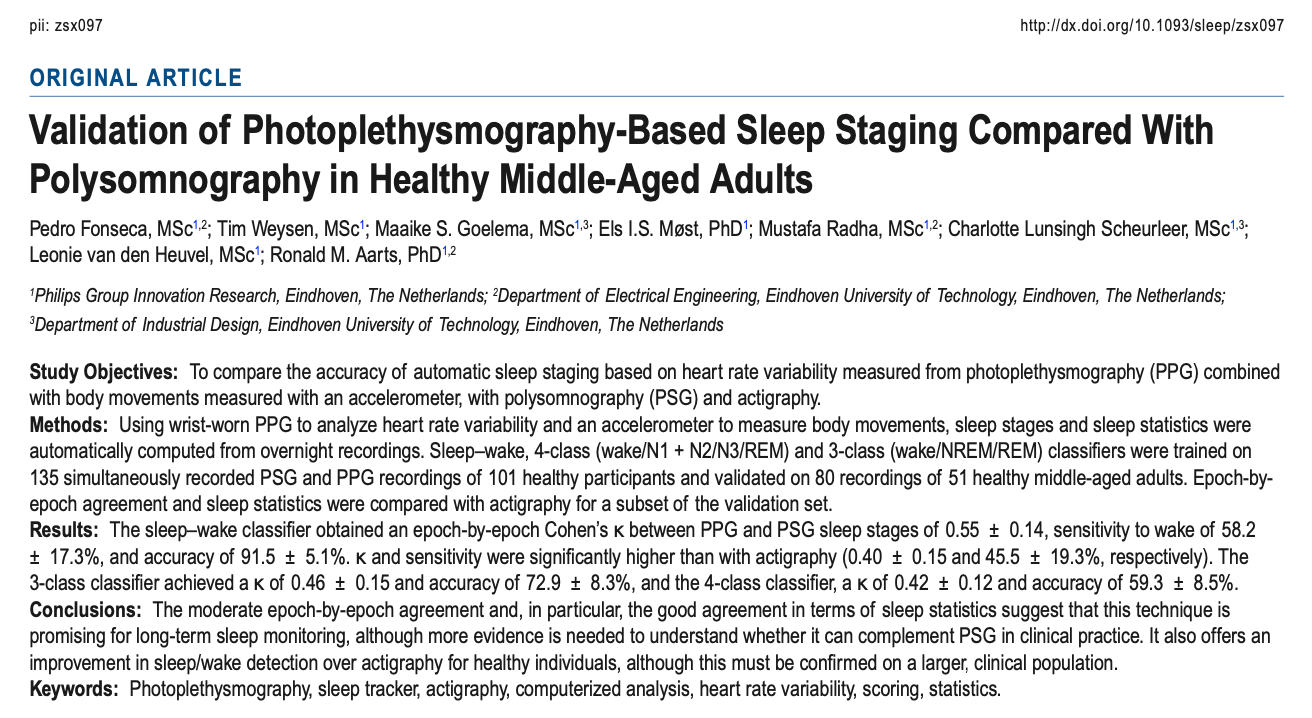Publications
Publications
There have been a number of articles published in support of Corsano’s and its partners’ scientific approach. In particular, the research underscores the need for adequate and continuous testing so that the risks posed by strokes can be mitigated.
Smartphone and wearable detected atrial arrhythmias in Older Adults: Results of a fully digital European Case finding study
The fully remote, investigator-initiated Smartphone and Corsano Health’s CardioWatch 287 wearable detected atrial arrhythmia in Older Adults Case finding study (Smart in OAC—AFNET 9) digitally enrolled participants ≥65 years without known atrial fibrillation, not receiving oral anticoagulation in Germany, Poland, and Spain for 8 weeks. Participants were invited by media communications and direct contacts. Study procedures adhered to European data protection. Consenting participants received a wristband with a photoplethysmography sensor to be coupled to their smartphone. The primary outcome was the detection of atrial arrhythmias lasting 6 min or longer in the first 4 weeks of monitoring.
Conclusion: Remote, digitally supported consumer-electronics-based screening is feasible in older European adults and identifies atrial arrhythmias in 5% of participants within 4 weeks of monitoring.
European Heart Journal – Digital Health, Volume 3, Issue 4, December 2022, Pages 610–625, https://doi.org/10.1093/ehjdh/ztac067
The accuracy of heartbeat detection using photoplethysmography technology in cardiac patients
This validation study showed that the Corsano 287 CardioWatch/Bracelet with PPG-technology can determine HR and RR-intervals with high accuracy in a cardiovascular patient population, with high quality output in different subgroups, especially when combined with a signal quality indicator. Due to their non-intrusive and convenient nature, wearable devices like these have great potential for high volume accessible long-term monitoring at-risk cardiac patients.
Continuous respiration rate monitoring using photoplethysmography technology in patients with Obstructive Sleep Apnea (Abstract)
Respiration rate is an important physiological parameter whose abnormality has been regarded as an important indicator of various serious illnesses. Photoplethysmography (PPG) in wearable sensors potentially plays an important role in early disease detection by making respiration rate measurements more accessible. We investigated the accuracy of a new non-invasive, continuous, wrist-worn and wireless monitoring PPG device (Corsano CardioWatch 287) in measuring respiration rate (RR) and pulse rate (PR) at rest.
J.M. Gehring 1, E.J. Japenga 1,2, L.C. Saeijs-van Niel 1, L.P ten Bosch-Paniagua 1, M.H. Frank 1,3
1. Department of Sleep Medicine, Haaglanden Clinics, Nieuwe Parklaan 11, The Hague, The Netherlands
2. Department of Respiratory Medicine, Haaglanden Medisch Centrum, Lijnbaan 32, The Hague, The Netherlands
3. Department of Oral Surgery, Haaglanden Clinics, Nieuwe Parklaan 11, The Hague, The Netherlands
Corsano Health Cardiowatch 287 USA Usability Study
Regulations and standards put the emphasis on usability and human factor design in the development of medical device and risk management. This paper explains the main challenges for wearable devices by showing how usability and human factors study was performed on the Corsano Cardiowatch 287 bracelet for body metrics monitoring.
Remote Design of a Smartphone and Wearable Detected Atrial Arrhythmia in Older Adults Case Finding Study: Smart in OAC – AFNET 9
Screening for atrial fibrillation and timely initiation of oral anticoagulation, rhythm management, and treatment of concomitant cardiovascular conditions can improve outcomes in high-risk populations.
AF detection
70 patients in an AF rhythm and 70 patients in sinus rhythm were recruited. Mean age was 73±12 (60% male) in the AF group, 59±20 in the sinus rhythm group (66% male). The BeatScanner app had a sensitivity of 89% (95% CI: 79-95%) and specificity of 67% (55- 78%). The Preventicus app had a sensitivity of 94% (86- 98%) and specificity of 96% (88-99%). There were 83/140 (59%) regular smartphone users, among whom 94% were interested in using their smartphone to self-screen for AF and 55% would pay for an app to do so. Almost all (96%) found the apps easy to use and 63% preferred the Preventicus app to the BeatScanner app. In a selected sample of hospital patients, the Preventicus app was more accurate for discriminating between AF and sinus rhythm than the BeatScanner app and was preferred by patients. Using the smartphones intrinsic function is a promising, simple and acceptable means of self-screening for AF.
EP Europace, Volume 19, Issue suppl_3, June 2017, Page iii234
Validation of Photoplethysmography-Based Sleep Staging Compared With Polysomnography
Corsano’s sleep analysis is powered by Philips Wearable Sensing algorithms. This clinical trial is using wrist-worn PPG to analyze heart rate variability and an accelerometer to measure body movements, sleep stages and sleep statistics were automatically computed from overnight recordings. Sleep–wake, 4-class (wake/N1 + N2/N3/REM) and 3-class (wake/NREM/REM) classifiers were trained on 135 simultaneously recorded PSG and PPG recordings of 101 healthy participants and validated on 80 recordings of 51 healthy middle-aged adults. The sleep–wake classifier obtained an epoch-by-epoch Cohen’s κ between PPG and PSG sleep stages of 0.55 ± 0.14, sensitivity to wake of 58.2 ± 17.3%, and accuracy of 91.5 ± 5.1%. κ and sensitivity were significantly higher than with actigraphy (0.40 ± 0.15 and 45.5 ± 19.3%, respectively).
The Effectiveness of Utilizing HRV Indices as a Predictor of ACFT Performance Outcomes
The Army Combat Fitness Test (ACFT) is a performance assessment used by the U.S. Army to assess a cadet’s strength, endurance, and agility with a series of six events to ensure that cadets are combat ready. Heart rate variability (HRV) is an instrument that measures cardiac autonomic modulation. SI was measured and calculated by using the CardioMood (sister company Corsano) equation n(SI = [Amplitude of Mode%]/[2*Mode* (RRmax – RRmin)]
Military Medicine, usad009, https://doi.org/10.1093/milmed/usad009








